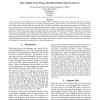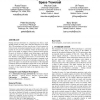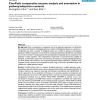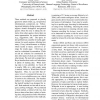617 search results - page 29 / 124 » Optimizing web search using social annotations |
LREC
2010
13 years 11 months ago
2010
After several years of development, the vision of the Semantic Web is gradually becoming reality. Large data repositories have been created and offer semantic information in a mac...
HT
2007
ACM
14 years 1 months ago
2007
ACM
Finding relevant information in a hyperspace has been a much studied problem for many years. With the emergence of so called Web 2.0 technologies we have seen the use of social sy...
BMCBI
2008
13 years 9 months ago
2008
Background: Once a new genome is sequenced, one of the important questions is to determine the presence and absence of biological pathways. Analysis of biological pathways in a ge...
ICDE
2010
IEEE
14 years 9 months ago
2010
IEEE
The proliferation of electronic content has notably lead to the apparition of large corpora of interrelated structured documents (such as HTML and XML Web pages) and semantic annot...
EMNLP
2009
13 years 7 months ago
2009
Three methods are proposed to classify queries by intent (CQI), e.g., navigational, informational, commercial, etc. Following mixed-initiative dialog systems, search engines shoul...




